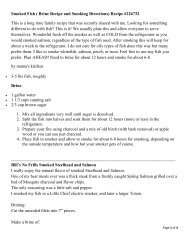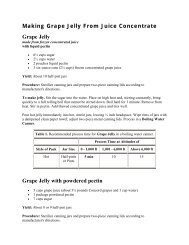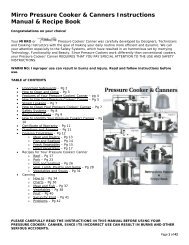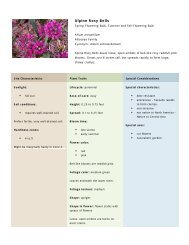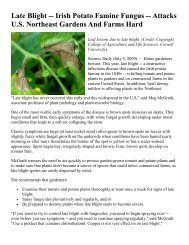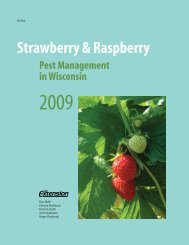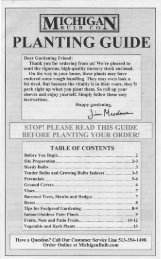Growing Blackberries in Your Home Garden, EC 1303 (Oregon ...
Growing Blackberries in Your Home Garden, EC 1303 (Oregon ...
Growing Blackberries in Your Home Garden, EC 1303 (Oregon ...
- No tags were found...
Create successful ePaper yourself
Turn your PDF publications into a flip-book with our unique Google optimized e-Paper software.
The fruit<strong>in</strong>g season extends from early July tofrost, depend<strong>in</strong>g on the variety.Semierect blackberries produce very vigorous,thick, arch<strong>in</strong>g canes that benefit from summerand w<strong>in</strong>ter prun<strong>in</strong>g. Cultivars <strong>in</strong>clude ‘TripleCrown’, ‘Loch Ness’, and ‘Chester Thornless’.For detailed <strong>in</strong>formation on the cultivars with<strong>in</strong>each type, see Blackberry Cultivars for <strong>Oregon</strong>,<strong>EC</strong> 1617.Growth and fruit<strong>in</strong>g cycleAll blackberry plants are perennial; the rootsand the base of the plant (crown) live for manyyears. The canes are biennial; they grow 1 year(primocanes), produce fruit the follow<strong>in</strong>g year(floricanes), and die after harvest. All types ofblackberries produce new canes each year fromthe crown, and erect types also produce new canesfrom the roots. Dur<strong>in</strong>g the grow<strong>in</strong>g season, bothnew vegetative primocanes (which will fruit nextyear) and fruit<strong>in</strong>g floricanes (which will die <strong>in</strong> thew<strong>in</strong>ter) are present.After harvest, the floricanes are removed, andthe primocanes, which will fruit the follow<strong>in</strong>gyear, are tra<strong>in</strong>ed. In some types of blackberries, theprimocanes are also pruned.Primocane-fruit<strong>in</strong>g (sometimes called “fallfruit<strong>in</strong>g” or “everbear<strong>in</strong>g”) blackberries are anexception to this fruit<strong>in</strong>g pattern. This type of erectblackberry is the only k<strong>in</strong>d that produces flowersand fruit on the current-season primocanes. Thefruit<strong>in</strong>g season is from late August to the first fallfrost.Blackberry canesThere are two names for a blackberry cane,depend<strong>in</strong>g on whether the cane is <strong>in</strong> its first orsecond year of growth.Primocanes: first year of growth; most typesproduce no fruit on these canes.Floricanes: second year of growth; these canesproduce flowers and fruit and then die.Select<strong>in</strong>g a site<strong>Blackberries</strong> produce best <strong>in</strong> full sun, but theytolerate partial shade.<strong>Blackberries</strong> are more tolerant to heavy soilsthan any other berry crop. However, it’s best toselect a site with good dra<strong>in</strong>age. Plants grow best<strong>in</strong> a well-dra<strong>in</strong>ed, fertile, loam soil with moderatewater-hold<strong>in</strong>g capacity.Select<strong>in</strong>g a cultivarThe various types of blackberries require differentcare, and cultivars differ greatly <strong>in</strong> fruit<strong>in</strong>gseason, fruit and seed size, appearance, and flavor.All types are self-fruitful, so you need only onecultivar for poll<strong>in</strong>ation and fruit production. Forcultivar descriptions, see Blackberry Cultivars for<strong>Oregon</strong>, <strong>EC</strong> 1617.Establish<strong>in</strong>g your plant<strong>in</strong>gPrepar<strong>in</strong>g the soilYou should be able to keep your blackberryplant<strong>in</strong>g productive for 15 to 20 years, so chooseand prepare a site carefully.Elim<strong>in</strong>ate all perennial weeds. Prevent weedsfrom go<strong>in</strong>g to seed!Almost any soil type is suitable for blackberriesas long as the dra<strong>in</strong>age is good. <strong>Blackberries</strong>grow best when the soil pH is between 5.5 and 7.Test soil pH the year before you plant. (For more<strong>in</strong>formation about soil test<strong>in</strong>g, see LaboratoriesServ<strong>in</strong>g <strong>Oregon</strong>: Soil, Water, Plant Tissue, andFeed Analysis, EM 8677, and Soil Sampl<strong>in</strong>g for<strong>Home</strong> <strong>Garden</strong>s and Small Acreages, <strong>EC</strong> 628.) Ifthe soil is too acidic (pH below 5.5), add lime tothe soil as recommended by the soil analysis.A good supply of soil organic matter improvesaeration and dra<strong>in</strong>age and <strong>in</strong>creases water-hold<strong>in</strong>gcapacity. Apply organic matter the summer or fallbefore you plant. Manure is a good source. Useabout 2 cu yd per 100 sq ft of plant<strong>in</strong>g area. Youalso can use decomposed (rotted) compost. Useonly materials that you th<strong>in</strong>k are free from <strong>in</strong>sectsand weed seeds.2




